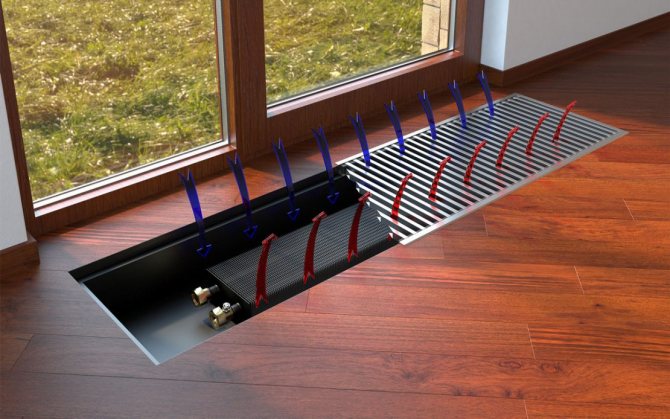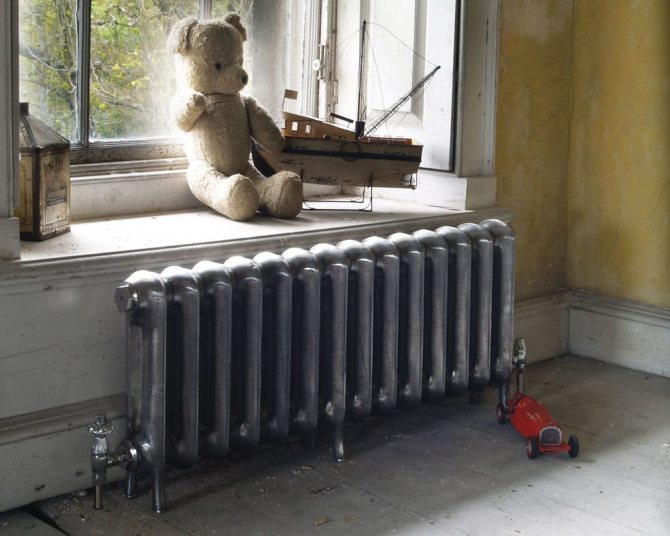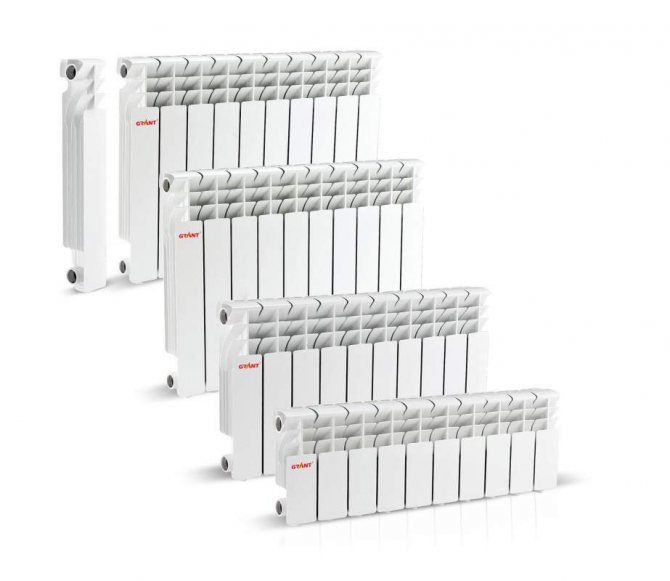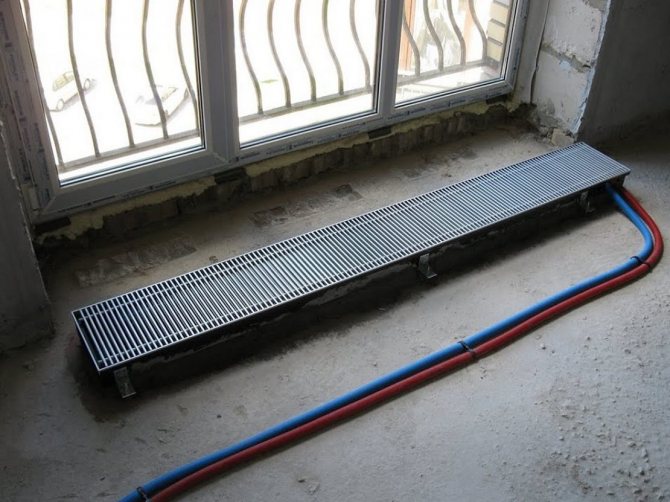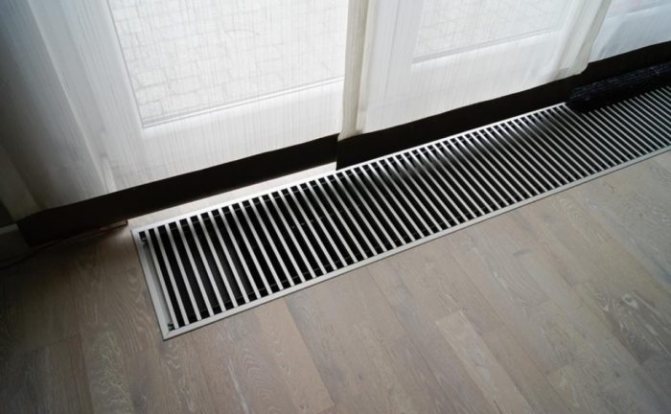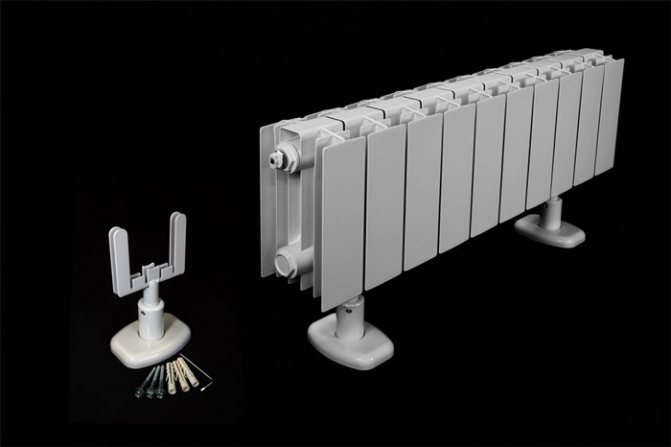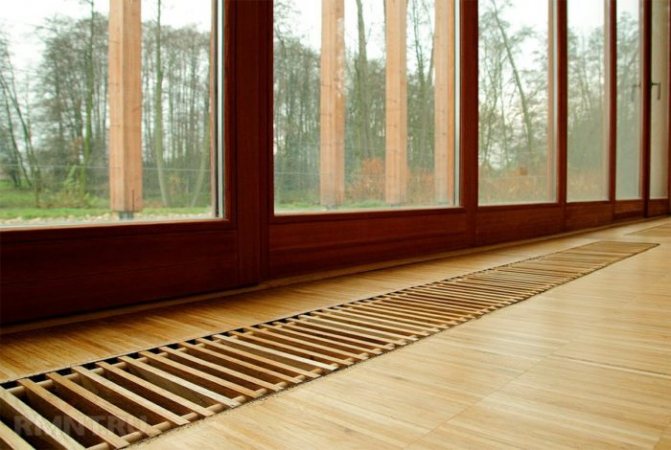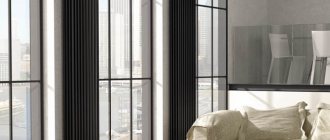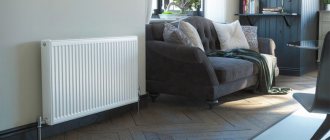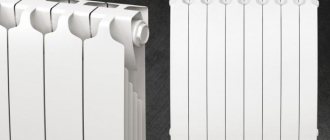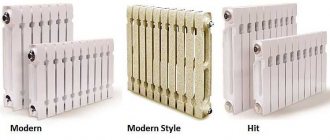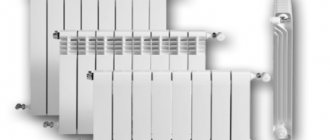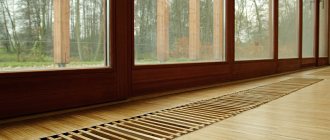Heating systems as an element of the interior
In each model line of equipment for creating heating, there is a segment where radiators of low height are presented. This group includes products in which this parameter does not exceed 450 millimeters. A low heating radiator under the window is indispensable for arranging heating for constantly soaking and cold walls facing the street, along their entire length.
Such devices are used in the event:
- large panoramic windows;
- the location of the heat supply system in the baseboards.

When choosing heating equipment, you need to take into account a number of technical parameters of products:
- material of manufacture;
- dimensions;
- power;
- resistance to corrosive processes;
- scope, etc.
Aluminum horizontal radiators
The lowest aluminum heating radiators for panoramic windows have a height of 24.5 centimeters.


Similar models are produced by foreign firms:
- Sira. The company manufactures miniature radiators with heat dissipation in the range of 89 - 97 W (products Rovall 80, Rovall 100, Swing, Alux 80 and Alux 100).
- Global. We offer a low cast radiator Gl-200/80 / D, which is designed for installation in a heating system with an operating pressure of up to 16 Bar.
In this segment of the domestic heating equipment, the most popular are radiators Rifar Base 200 and Rifar Forza 200. The number 200 indicates that their center-to-center distance is 20 centimeters.


Low horizontal aluminum radiators have a number of important advantages:
- light weight - during installation, the help of a construction team is not required;
- high degree of heat transfer;
- when the control valve is turned, the battery quickly responds to changes in the parameters of the working environment;
- a small amount of water is required to completely fill the system.
Of the negative characteristics of aluminum batteries, it should be noted:
- chemical activity inherent in this metal, which affects the quality of the water used;
- the softness of the material of manufacture, so the product is easy to deform.
The disadvantages of aluminum heating devices can be dealt with if thorough water treatment is carried out before their operation, which is recommended by the instructions of manufacturers.
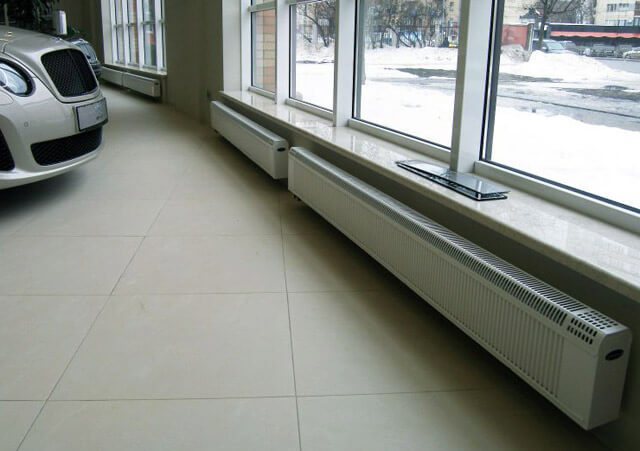

Manufacturers of aluminum radiators do not recommend using them in the heat supply systems of multi-apartment buildings, where the quality of hot water is in serious doubt.
If you plan to install an aluminum battery under panoramic windows, you should not forget that this metal has poor contact with copper and alloys that include copper. Galvanized fittings work without problems with aluminum. You can also install wall-mounted electric heating radiators, they are also quite effective.
Scope of use of floor radiators
First, let's figure out where heating devices are used that are installed on the floor.


It is advisable to use water floor heating batteries in such cases:
- In rooms where, for one reason or another, it is impossible to install traditional radiators for wall mounting. This often happens in houses where the walls are made of loose material (aerated concrete, foam concrete) or sheathed with plasterboard. Even light aluminum appliances must not be hung on them.
- In shop windows and malls, low floor heating radiators are used for panoramic windows.Such glazing should not be left without a thermal curtain, because condensation will accumulate on the windows and ice will form.
Unlike mounted heating units, floor-standing radiators are installed only on the floor, they are not attached to the walls. The height of these devices is less than that of their sectional counterparts. The machine stand is rigidly attached to the floor.
Advantages and disadvantages
The advantages that low heating radiators have include the following:
- the unit can be mounted anywhere, regardless of the height of the windows;
- a low heater saves free space in the room;
- due to its stylish design and attractive appearance, the battery does not spoil the interior of the room, it fits into any room design;
- can be installed in a room with panoramic windows to create a thermal curtain in front of them;
- during installation, the material and strength of the walls does not matter, because the batteries are not attached to them.
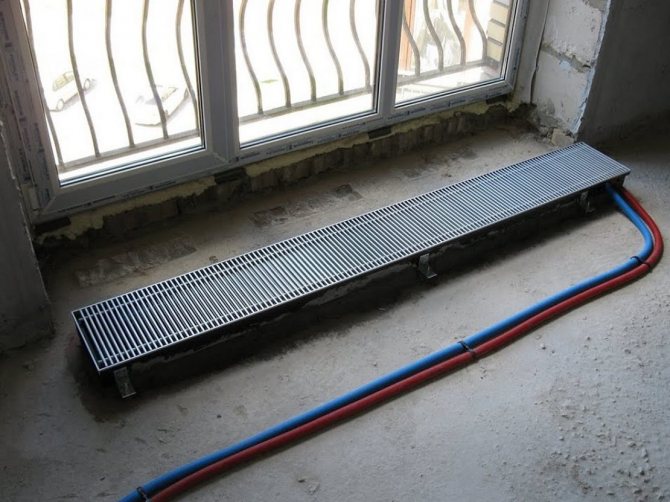

Such heating devices also have disadvantages, they are as follows:
- To connect the battery to the heating system, you need to lay pipes in the floor screed, because they will interfere with the arrangement of furniture. Concealed laying of pipelines is considered not the best option, because it is more difficult to maintain and repair networks.
- The heat from these heating devices is unevenly distributed, so the unit is not suitable for heating rooms of considerable height. However, some parts of the room may not be heated at all.
- Due to the hidden laying of pipelines, the floor screed in the room is made of a certain height, which creates difficulties in fixing the radiators.
A significant disadvantage of floor heating units is that they are more expensive than sectional hinged batteries, and the room is heated worse.
Varieties of floor standing batteries
All horizontal heating radiators that are mounted on the floor are divided into several types depending on the material of execution:
- Cast iron batteries were widely used in the last century, but they cannot boast of aesthetic appeal. Their main disadvantage is that the structure quickly silts up inside, so it needs to be cleaned regularly (about once every three years). Cast iron can crack under mechanical stress. The same happens with water hammering.
- Steel radiators are more popular today. They are quite durable and visually attractive. However, lamellar steel tools often leak in the area of the weld.
- The most reliable and beautiful bimetallic aggregates. There is a steel core inside the aluminum housing. Due to this, the heat transfer of the device is quite high, and the optimal strength allows them to be mounted in centralized networks with high pressure.
- Aluminum batteries are the lightest, but they are not designed for high pressure in the network, therefore, they are used only in stand-alone systems. It is important to carefully select the material of pipes and fittings, because aluminum forms galvanic pairs with some metals.
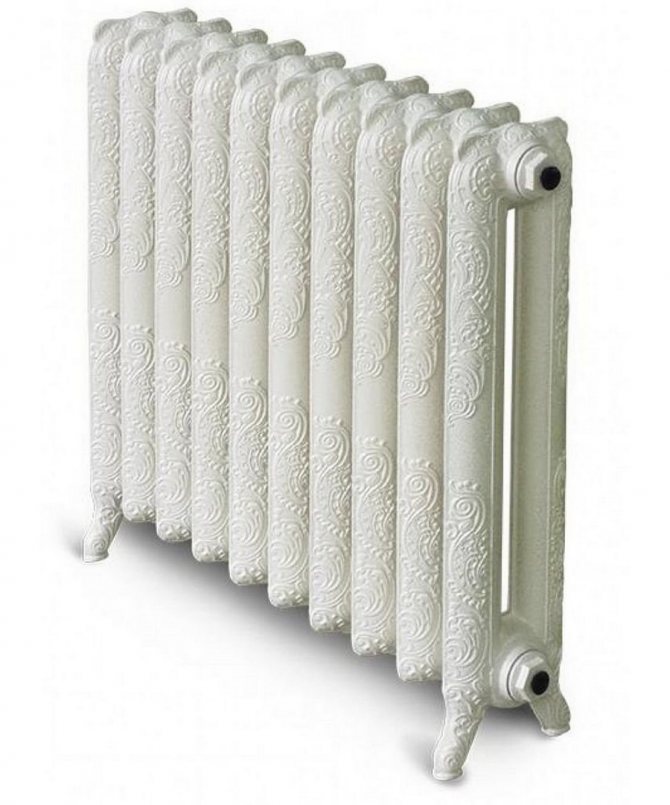

By design, floor units are panel and sectional. Panel batteries are made only of steel, while sectional batteries are made of bimetal, cast iron or aluminum. In addition, all heating devices come in different heights.
Important! The smallest heat losses with a small number of sections have higher batteries.
Bimetallic devices for panoramic windows
This type of radiator belongs to the heat supply equipment, the high cost of which corresponds to the quality as much as possible.
Bimetallic radiators are different:
- High indicators of working pressure.
- Compatibility with other metals.In them, aluminum is used only for the manufacture of a shell that increases the aesthetics of appearance and heat transfer. As for the inner case, equipped with outlets for connection to the system, it is made of stainless steel or black steel.
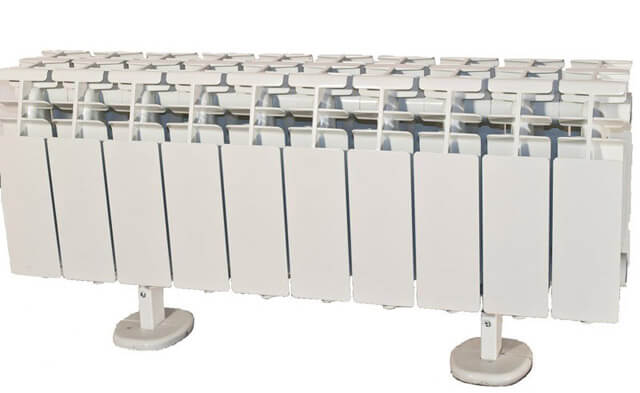

According to experts, it is bimetallic radiators that are the best option for systems connected to district heating. Their use to supply heat to private households is unjustified in relation to the margin of safety and cash costs.
The height of bimetallic radiators for panoramic windows ranges from 24.5 to 45 centimeters.
Built-in appliances
For heating office, retail and residential buildings, heating radiators built into the floor are used. They can be used in greenhouses and greenhouses to create comfortable temperature conditions for plants. The operation of the device is based on the principle of convection. Built-in units contribute to intensive air circulation, therefore they heat the room faster and more efficiently, which reduces heating costs.
Worth knowing! On sale there are built-in radiators with automatic temperature control, condensate drainage function, the ability to program the microclimate in the room.
The unit has a simple design. A heat exchanger with convective plates is located inside the metal housing. The body of the device is built into the floor, and from above it is closed with a sturdy decorative grill.
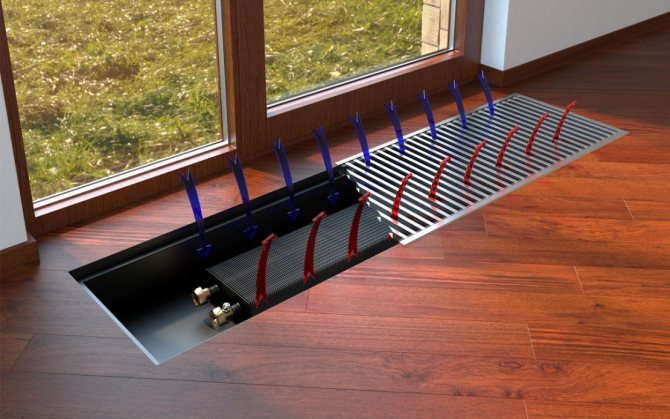

For places with high humidity, it is better to buy a stainless steel device, and in a room with a normal microclimate, galvanized steel batteries are used. To protect the body and pipes from corrosion, they are powder coated.
In the interior of the room, only the radiator grill is visible from such a device. In its manufacture, wood, aluminum, marble or one of the varieties of steel (stainless or galvanized) are used.
By design, the grilles are divided into roll and linear. The last grates can only be lifted as a whole, while the second type is rolled up. Rolled decorative linings consist only of transverse beams, and in linear structures there are also longitudinal stiffeners. Since they will walk on the grill and put furniture on it, no plastic parts are used in its construction.
Types and scope of use
Built-in batteries are commonly used in the following locations:
- public and residential premises with panoramic glazing;
- greenhouses;
- galleries, museums and exhibition halls;
- offices and commercial premises;
- private and apartment buildings.
Important! The efficiency of underfloor radiators with a fan increases up to 90%. This is achieved through improved air circulation. The fan can be turned off if necessary.
Devices with a fan have special foam rubber gaskets to reduce the noise level in the room. The unit has electronic temperature sensors, regulators for setting the temperature and fan speed.
Related article: Lathing for siding around windows
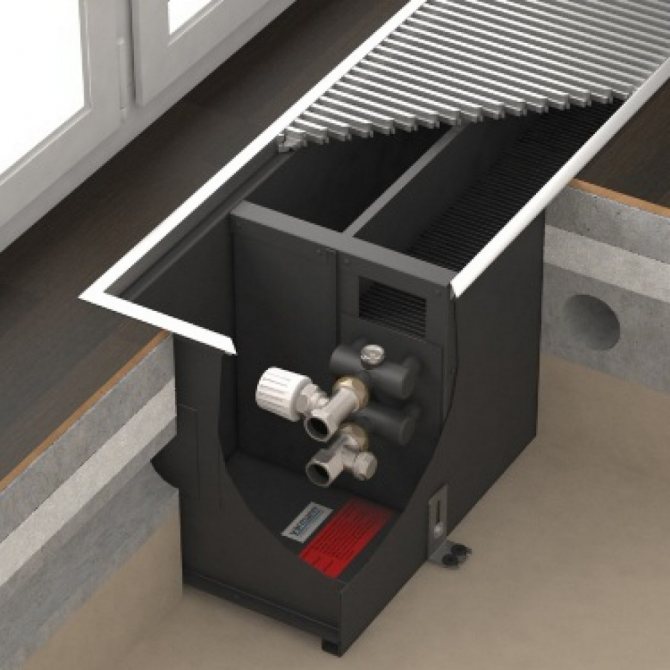

There are two types of built-in batteries:
- Water-based floor heating radiators consist of a metal tube on which convection plates are threaded. Tubes of copper, steel or aluminum are usually used. The unit is connected to the water heating system of a house or apartment. In centralized networks, the copper pipe structure cannot be used.
- There is a closed heating element inside the electric built-in heater. To increase the heat transfer area, plates of steel, aluminum or copper are welded onto it. Stainless steel heating elements will last the longest. These radiators are fused for safe operation.
On a note! On sale there are floor radiators with fans that can both heat the air in the room and cool it.
Some varieties have built-in filters that allow them to purify air from the street and, after heating, supply it to the room. For the convenience of controlling the operation of the device, you can purchase a control panel for it. Usually on sale there are built-in radiators of a straight-line configuration, but a semicircular device can be made to order.
Pros and cons of embedded radiators
The advantages of underfloor heating batteries include the following:
- The unit can be installed anywhere.
- The device can be used in rooms of any size, because it does not take up space, being installed in a niche under the floor. You can walk on the grill and put furniture on it.
- The battery does not need special care, it is easy to repair and maintain.
- Due to the fact that the unit is not visible in the interior, it can be used in rooms decorated in any style.
- The safety of the device allows you to mount it in a children's room.
- When installed near a doorway or under panoramic windows, the radiator forms a heat curtain that prevents heat loss.
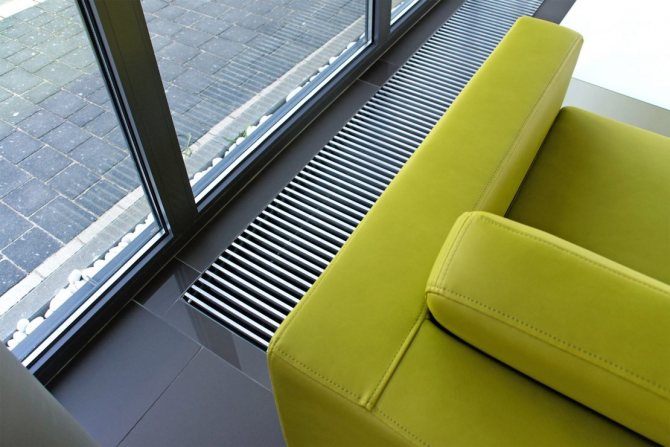

But when choosing this type of heating devices, one should not forget about their shortcomings.
The disadvantages include the following:
- Installation and connection of this device is quite laborious. It is better to entrust all work to professional craftsmen.
- To install the device in the floor, the screed has to be made high enough, which leads to a significant consumption of materials.
- Heating efficiency is noticeably reduced in rooms over three meters high.
- The price of built-in heating devices is higher than that of their wall-mounted counterparts.
During the operation of the built-in radiator, active dust circulation occurs in the room. This worsens the well-being of young children and negatively affects the health of allergy sufferers.
Selection Tips
When buying, pay attention to the dimensions of the unit and its power. Also decide in advance if you need an appliance with a built-in fan.
When choosing, consider the following parameters:
- pressure in the heating system;
- the purity of the coolant and its compositions are important for the choice of pipe material in water units;
- the diameter of the pipeline can be ignored, because there are adapters on sale;
- type of wiring (one-pipe or two-pipe);
- humidity in the room (the material of the body and pipes depends on this, as well as the need for a condensate drainage function).
It is advisable to use floor and built-in heating devices in the room where the parameters of a conventional mounted radiator do not meet the requirements or their installation is generally impossible.
Steel Low Batteries
When it is necessary to equip a very low heating system with a height of 100, 150 or 180 millimeters, tubular steel radiators can be installed. These products are made rectilinear and in the form of structures of an unusual shape, repeating the configuration of the space under the window.
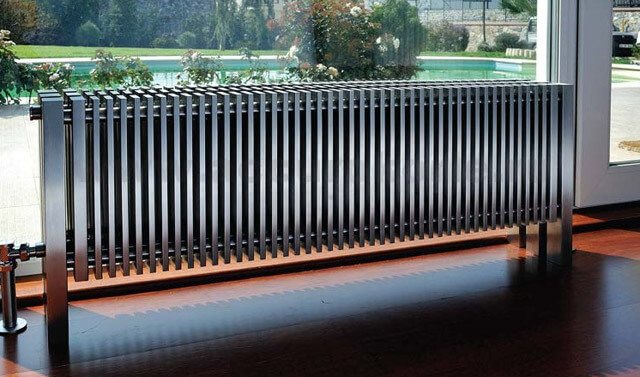

Tubular heating devices function quite well in different systems, regardless of the method of circulation of the working medium - forced or natural. There are also thin heating radiators that take up little space.
Heating in skirting boards
Relatively recently, a new and lowest way of creating heating has appeared. In this case, the heat supply structure consists of copper tubes, finned with plates, due to which heat transfer is increased. Water circulates through them.
The pipes are laid around the perimeter of the room and covered with special metal skirting boards. Such a heating structure has the smallest dimensions. It is 30 millimeters wide and 100-200 millimeters high (depending on the power of the system).
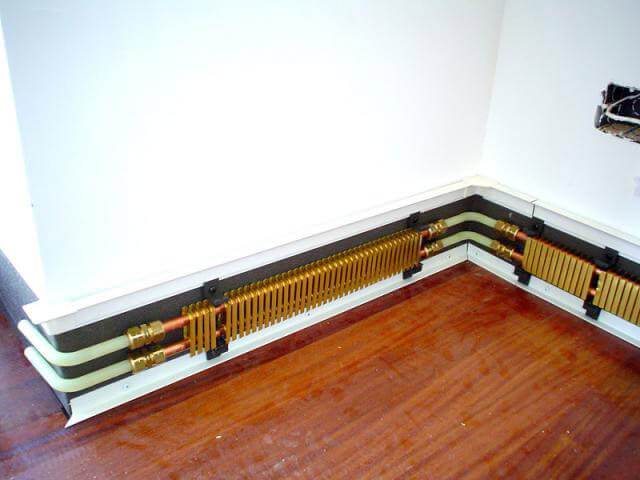

Heating in skirting boards has the following advantages:
- Great opportunities for the embodiment of design solutions in the interior.
- Even distribution of warm streams along the walls.
When a unique design is created in a room, it is low radiators for stained-glass windows that allow you to correctly and beautifully fit the heating system into the interior.
Installing the battery in the system
Choosing one or another type of low radiator, it is necessary to determine its parameters, based on the size of the window and the required heat transfer. The length of the heat exchanger should be equal to the width of the opening or exceed it by 200-300 mm.
Having the skill of owning the necessary tool, it is not difficult to connect the radiator to the system with your own hands.
The proposed instruction will help with this:
- determine the type of system - one- or two-pipe;
- determine the most optimal connection scheme - diagonal, one-sided or bottom;
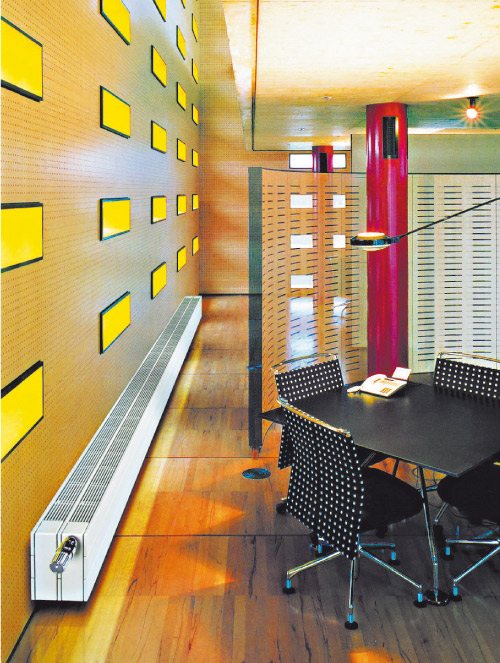

Unobtrusive interior element
- further, we install taps on the supply and outlet nozzles, which allow to shut off the coolant supply in an emergency;
- screw the Mayevsky tap (top) and the plug (bottom) into the remaining holes.
- pre-assembly can be carried out dry, the final connection is carried out using linen winding and plumbing paste;
- batteries made of various metals can be connected to heating systems made of metal, metal-plastic and polypropylene pipes.


Installation in pictures
